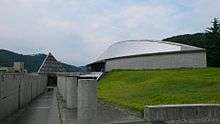Iwajuku
Iwajuku (岩宿遺跡, Iwajuku iseki) is an archaeological site in Midori, Gunma Prefecture, Japan. The site was excavated in 1949 by amateur archaeologist Aizawa Tadahiro, who confirmed the existence of two cultural strata, one of which contained small tools such as projectile points and blades made of obsidian and agate from the Japanese Paleolithic period. This overturned the prevalent theory that human habitation of the Japanese archipelago began with the Jōmon period, and indicated that humans had resided before the 10th millennium BC, or since the end of the last Ice Age.[1][2]
岩宿遺跡 | |
 Iwajuku Museum | |
| Region | JP |
|---|---|
| Coordinates | 36°23′57″N 139°17′09″E |
| Type | landmark |
| History | |
| Founded | 10th millennium BC |
| Periods | Japanese Paleolithic |
| Site notes | |
| Ownership | Public |
| Public access | Yes |
| Website | www |
The site was designated a National Historic Site by the Japanese government’s Agency for Cultural Affairs in 1979.[3]
References
- Keiji Imamura. Prehistoric Japan: new perspectives on insular East Asia p. 19.
Notes
- Keiji Imamura. Prehistoric Japan: new perspectives on insular East Asia p. 19.
- "Ancient Jomon of Japan", Habu Jinko, Cambridge Press, 2004 Archived 2007-08-27 at the Wayback Machine
- 史跡名勝天然記念物 Agency for Cultural Affairs (in Japanese)
This article is issued from Wikipedia. The text is licensed under Creative Commons - Attribution - Sharealike. Additional terms may apply for the media files.